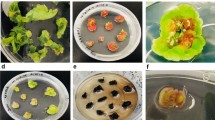Abstract
Celosia plumosus L. is one of the most common gardening plants worldwide. The C. plumosus L. transformation system established by other research team should be useful for modifying physiological, medicinal, and horticultural traits. Though morphological modification of C. plumosus L. would be critical in terms of its commercial value, few attempts have been reported until now. In modification of gardening plants, many potentially useful genes that are involved in the pathways associated with flower and plant morphology have been cloned. Transcription factors regulating plant development and biosynthetic or regulatory genes involved in plant hormones are common candidates. KNAT1, isolated from Arabidopsis, is a knotted1-like homeobox (knox), and it is expressed in the shoot apical meristem and not in determinate organs. Previous reports have indicated that ectopic expression of KNAT1 in Arabidopsis changes simple leaves into lobed leaves or rumpled leaves. Therefore, this transcription factor might regulate plant morphology. In this work, we constructed the binary vector pBIN-pMD-18T, which contained the GFP and KNAT1 coding sequence, and transformed them into C. plumosus L. plants by Agrobacterium tumefaciens. Our results show that the KNAT1-GFP fusion protein was selectively located in the nucleus of roots and leaves, consistent with a potential function as transcription factor reported by other research teams. We observed that some 35S:KNAT1-GFP plants display lobed or rumpled leaves, partite leaves. Moreover, overall plant morphology was altered in extreme phenotype category, i.e., dwarfed. Together, these morphological modifications of C. plumosus L. can have potential practical applications.




Similar content being viewed by others
References
Alvarez J, Guli CL, Yu XH, Smyth DR (1992) Terminal flower: a gene affecting inflorescence development in Arabidopsis thaliana. Plant J 2:103–116
Amaya I, Ratcliffe OJ, Bradley DJ (1999) Expression of CENTRORADIALIS (CEN) and CEN-like genes in tobacco reveals a conserved mechanism controlling phase change in diverse species. Plant Cell 11:1405–1418
Barton MK, Poethig S (1993) Formation of the shoot apical meristem in Arabidopsis thaliana: an analysis of development in the wild type and shoot meristemless mutant. Development 119:823–831
Chuck G, Lincoln C, Hake S (1996) KNAT1 induces lobed leaves with ectopic meristems when overexpressed in Arabidopsis. Plant Cell 8:1277–1289
Clark SE, Jacobsen SE, Levin JZ, Meyerowitz EM (1996) The CLAVATA and SHOOTMERISTEMLESS loci competitively regulate meristem activity in Arabidopsis. Development 122:1567–1575
Endrizzi K, Moussian B, Haecker A, Levin JZ, Laux T (1996) The SHOOT MERISTEMLESS gene is regulated for maintence of undifferentiated cells in Arabidopsis shoot and floral meristems and acts at a different regulatory level than the meristem genes WUSCHEL and ZWILLE. Plant J 10:967–979
Gan S, Amasino RM (1995) Inhibition of leaf senescence by autoregulated production of cytokinin. Science 270:1986–1988
Jackson D, Veit B, Hake S (1994) Expression of maize KNOTTED-1 related homeobox genes in the shoot apical meristem predicts patterns of morphogenesis in the vegetative shoot. Development 120:405–413
Kerstetter R, Vollbrecht E, Lowe B, Veit B, Yamaguchi J, Hake S (1994) Sequence analysis and expression patterns divide the maize knotted1-like homeobox genes into two classes. Plant Cell 6:1877–1887
Kerstetter RA, Laudencia-Chingcuanco D, Smith LG, Hake S (1997) Loss-of- function mutations in the maize homeobox gene, knotted1, are defective in shoot meristem maintenance. Development 124:3045–3054
Lincoln C, Long J, Vamaguchi J, Serikawa K, Hake S (1994) A knottedl-like homeobox gene in Arabidopsis is expressed in the vegetative meristem and dramatically alters leaf morphology when overexpressed in transgenic plants. Plant Cell 6:1859–1876
Meng LS, Ding WQ, Hu X, Wang CY (2009) Transformation of PttKN1 gene to cockscomb. Acta Physiol Plant 31:683–691
Meng LS, Sun XD, Li F, Liu HL, Feng ZH, Zhu J (2010) Modification of flowers and leaves in Cockscomb (Celosia cristata) ectopically expressing Arabidopsis ASYMMERTIC LEAVES2-LIKE38 (ASL38/LBD41) gene. Acta Physiol Plant 32:315–324
Muehlbauer GJ, Fowler JE, Freeling M (1999) Sectors expressing the homeobox gene liguleless3 implicate a time-dependent mechanism for cell fate acquisition along the proximal-distal axis of the maize leaf. Development 124:5097–5106
Reiser L, Sánchez-Baracaldo P, Hake S (2000) Knots in the family tree: evolutionary relationships and functions of Knox homeobox genes. Plant Mol Biol 42:151–166
Sinha NR, Williams RE, Hake S (1993) Overexpression of the maize homeobox gene KNOTTED-1 causes a switch from determinate to indeterminate cell fates. Genes Dev 7:787–795
Smith L, Greene B, Veit B et al (1992) A dominant mutation in the maize homeobox gene KNOTTED1 causes its ectopic expression in leaf cells with altered fates. Development 116:21–30
Tanaka Y, Katsumoto Y, Brugliera F, Mason J (2005) Genetic engineering in floriculture. Plant Cell Tissue Organ Cult 80:1–24
Vollbrecht E, Veit B, Sinha N, Hake S (1991) The developmental gene Knotted-1 is a member of a maize homeobox gene family. Nature 350:241–243
Winefield C, Lewis D, Arathoon S, Deroles S (1999) Alteration of Petunia plant from through the introduction of the rolC gene from Agrobacterium rhizogenes. Mol Breed 5:543–551
Acknowledgments
This research was specially supported by GanSu College of Traditional Chinese Medicine and ShaoXing University.
Author information
Authors and Affiliations
Corresponding author
Additional information
Communicated by L. A. Kleczkowski.
S.-B. Sun and J.-P. Song contributed equally to this work.
Rights and permissions
About this article
Cite this article
Sun, SB., Song, JP. & Yang, J. Overexpressing Arabidopsis KNAT1 gene in Celosia plumosus L. causes modification of plant morphology. Acta Physiol Plant 33, 1597–1602 (2011). https://doi.org/10.1007/s11738-010-0694-4
Received:
Revised:
Accepted:
Published:
Issue Date:
DOI: https://doi.org/10.1007/s11738-010-0694-4




